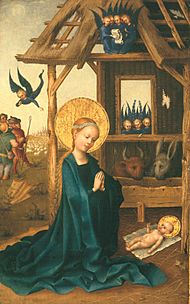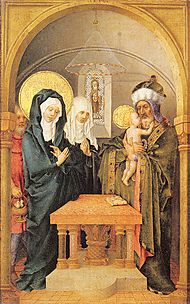Diptych facts for kids
A diptych is a special kind of artwork or object made from two flat pieces. These pieces are usually joined together, often with hinges, so they can open and close like a book. The word "diptych" comes from an ancient Greek word meaning "folded in two."
Diptychs have been used for many different things throughout history. They can be beautiful paintings, handy writing tablets, or even clever tools like sundials.
Contents
Diptychs in Art
Many famous artworks are diptychs. Painters often used two panels to create a single piece. These art diptychs were popular for religious scenes. They could show two different parts of a story. Sometimes, the panels would show a person praying on one side and a holy figure on the other.
Why Two Panels?
Having two panels offered several benefits. It helped protect the artwork when it was closed. It also made the art easier to carry. This was useful for artists or people who traveled. Diptychs were often used as small altarpieces in churches or homes.
Famous Examples
Artists like Conrad von Soest and Stefan Lochner created beautiful diptychs. Their works often showed detailed religious scenes. These pieces are now displayed in museums around the world. They give us a glimpse into art from hundreds of years ago.
Diptychs for Writing
Long ago, diptychs were also used as writing tablets. In ancient Rome, people used them for notes or letters. These tablets were usually made of wood. The inside surfaces were covered with a thin layer of wax. People would write on the wax using a pointed tool called a stylus.
Consular Diptychs
A special type of writing diptych was the "consular diptych." These were often made of ivory. Important Roman officials called "consuls" would give them as gifts. They were a way to celebrate their time in office. These ivory diptychs were beautifully carved. They are now valuable historical objects.
Diptychs as Tools
Besides art and writing, diptychs were also used to make tools. One clever example is the diptych sundial. These portable devices helped people tell time using the sun.
Sundial Design
A diptych sundial had two hinged panels. When opened, one panel would cast a shadow onto the other. Lines and numbers on the panels would then show the time. They were popular before clocks became common. Many were beautifully decorated and very precise.
Images for kids
-
Barberini Ivory, Constantinople, 6th century, Louvre
-
Deesis, 17th-century icon. Left to right: Archangel Michael, Theotokos, John the Baptist, Archangel Gabriel (Historical Museum in Sanok, Poland).
-
Diptych sundial in the form of a lute, circa 1612
See also
 In Spanish: Díptico para niños
In Spanish: Díptico para niños










